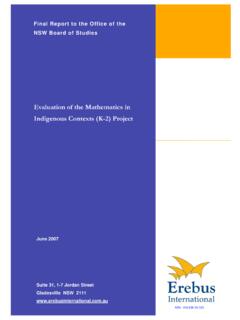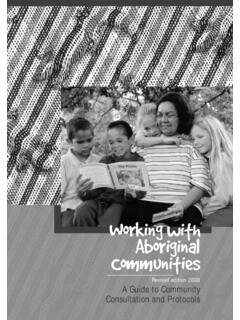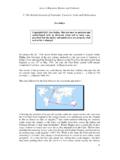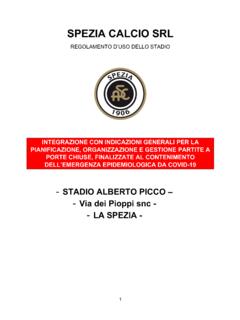Transcription of A NSW Aboriginal Education Timeline 1788-2007
1 A NSW Aboriginal Education Timeline 1788 2007 by Dr Allison Cadzow for the Board of Studies NSW Introduction This Timeline briefly outlines some turning points and events in NSW institutional Aboriginal Education from 1788 to 2007. Indigenous Australian people have sophisticated Education practices and systems based on spoken knowledge and teaching by experience and observation, which were developed well before 1788. Aspects of Aboriginal Education have both endured and changed over time, despite non- Aboriginal people s frequent efforts to improve upon, or destroy their knowledge and teachings. Aboriginal peoples early experiences of non- Aboriginal Education included missionary schools, mixed and segregated public schooling from 1880, and training institutions which focused on manual work.
2 Numerous Indigenous people and non-Indigenous supporters have fought against inequality in seeking to gain access to relevant public Education for Aboriginal children and adults. Their efforts have been central to the success of initiatives such as the establishment of Tranby College in the late 1950s, Aboriginal Education Consultative Groups in the 1970s, Aboriginal Studies subjects, language revival and teaching. Aboriginal and Torres Strait Islander communities are increasingly involved in Education planning and delivery, signalling a growing respect for Aboriginal people s abilities to learn and teach from multiple cultures of Education . An historical lack of access to educational opportunities, together with racism, economic disadvantage and health issues have left a legacy of problems faced by many Indigenous students and teachers today.
3 Yet hard-working teachers, students and community members have made significant achievements which are recognised in this Timeline as important elements of Aboriginal Education history in NSW. A note on the approach used The Timeline does not capture every important event in Aboriginal Education in NSW since 1788. It is a brief chronology with quotations from Indigenous educators, students, activists, authors and community members included to provide insights into NSW Indigenous people s personal and cultural experiences of Education . Case studies of school Education in Gulargambone (central west NSW) and Nulla Creek or Bellbrook (north coast NSW) explore segregation, access disputes and school history in more detail than is possible within a Timeline framework. We hope the Timeline and case studies inspire you to find out more about Aboriginal Education to learn about your school, your family and friends experiences, and to make some Education history of your own!
4 This document is provided for research purposes and may contain opinions that are not shared by the Board of Studies NSW. 1 Timeline 1789 The capture and English Education of Bennelong Governor Arthur Phillip organised the capture of Bennelong. Phillip attempted to teach Bennelong about English language and culture and to learn about Aboriginal people from Bennelong. References: Dark (1966) pp 84 85; Heiss & McCormack (2002) < > Associate Professor Anita Heiss (Wiradjuri) and Terri McCormack discussed Bennelong s attempt to educate non- Aboriginal people about his culture: While Bennelong suffered from the worst aspects of enculturation, he also represents those who tried to change the behaviour of Europeans on Aboriginal lands. Heiss & McCormack (2002). 1790 Attempts to educate individual Aboriginal children Convict George Bath adopted and provided a European style Education for James whose parents were shot by non- Aboriginal people near Toongabbie (Sydney).
5 Reference: Fletcher (1989a) p 15. 1796 An early Aboriginal experience of a NSW school Reverend Samuel Marsden attempted to provide a British Education for Tristan and sent him to school in Parramatta. Tristan was one of the earliest known Aboriginal people to attend a NSW school. The Marsden family attempted to train him as their house servant but he ran away from them in Rio while travelling to England in 1807. He eventually boarded a ship back to Sydney and died soon after arriving home. After this event, Marsden claimed that nothing could be done to educate Aboriginal people. References: Bridges (1968) p 228; Fletcher (1989a) p 15. 1815 22 Parramatta Native Institution (Sydney) The Native Institution was an experiment in Education established by Governor Lachlan Macquarie and former missionary William Shelley.
6 Aboriginal children (who educators thought were more easily influenced than adults) were taught to be labourers and servants for colonists. They were instructed in basic literacy skills, agriculture and craft and encouraged to convert to Christianity. Some students were brought to the school by force, and students were separated from their Aboriginal families and cultural influences. While several students achieved excellent results, they chose to return to their communities after schooling. References: J. Brook & Kohen (1991), Chapter 4; Read (2006); Fletcher (1989a) pp 19 21. This document is provided for research purposes and may contain opinions that are not shared by the Board of Studies NSW. 2 1821 Student achievement An Aboriginal student at the Native Institution and Sunday school received top marks in her examinations, ahead of non- Aboriginal students.
7 References: Brook and Kohen (1991) pp 250 251; Duncan (1997) p 193. A reporter noted: ..a black girl of fourteen years of age between three or four years in the school, bore away the chief prize, much to the satisfaction of the worthy judges and auditors. Sydney Gazette 17 April 1819, cited in Brook & Kohen (1991) p 251. 1822 3 Native Institution at the Black Town (Sydney) The Native Institution was relocated to Black Town, on one of the earliest land grants to Aborigi nal people assigned to Nurragingy-Colebee by Governor Macquarie. Problems with the Parramatta site including epidemics, partly contributed to the decision to relocate the school. Proximity to the Blacktown Aboriginal community and access to farms for practical teaching also influenced the move. Approximately 12 students attended.
8 References: Brook & Kohen (1991) pp 38 46, p 87, Chapter 7 pp 132 157; Fletcher (1989a) pp 21 22. 1825 Aboriginal students at Liverpool Orphan School (Sydney) Several students from the Blacktown Native Institution were moved to the Liverpool Orphan School as part of a mixed schooling trial. Governor Brisbane wanted to see if mixed schooling at the Orphan School would lead to the assimilation of Aboriginal children. References: Brook & Kohen (1991) pp 240 241; Fletcher (1989a) p 22. Mission Education at Lake Macquarie (Central Coast NSW) Reverend Threlkeld established a London Missionary Society mission at Lake Macquarie to preach Christianity to local Awabakal people. Later Threlkeld learnt from Biraban (John McGill) how to speak Awabakal. Under Biraban s tuition, Threlkeld eventually interpreted for Aboriginal prisoners at trials and publis hed early studies of the Awabakal language.
9 References: Bridges (1968) pp 233 234; Gunson (1967) pp 528 530. 1827 Scott-Hall segregated school established at Blacktown (Sydney) NZ Missionary William Hall and Archdeacon Scott attempted to revive the Native Institution at Blacktown. Maori, Aboriginal and non- Aboriginal children attended, though classes were racially segregated. Reading and writing lessons were provided and boys were trained in carpentry. This document is provided for research purposes and may contain opinions that are not shared by the Board of Studies NSW. 3 Fletcher (1989a) pp 22 23; Brook & Kohen (1991) Chapter 10, pp 204 228. 1829 Black Town Aboriginal School closed Remaining students were sent to Liverpool to compl ete their Education with Reverend Cartwright as their teacher. Cartwright wanted the children to remain segregated from the rest of the colony.
10 Students ran away frequently. References: Brook & Kohen (1991) p 225; Bridges (1968) pp 232 233; Ramsland (1986) pp 33 37. 1832 Anglican Church Missionary Society establishes Wellington mission and school (northern NSW) Reverend Handt and Reverend William Watson established a Christian mission and school at Wellington. They taught Aboriginal children using visual and oral approaches as well as music, recognising and using connections with Aboriginal Education techniques. Attendance was eventually forced, and parents hid their children, fearing their removal. References: Fletcher (1989a) pp 24 26; Edwards & Read (1997) p xi. 1837 Select Committee of House of Commons (UK) inquired into the conditions of Indigenous people in British Colonies The Select Committee recommended a system of Protectors for Aboriginal people in Victoria, which influenced policy in NSW.










